How business-to-business electronic commerce is evolving on the Net
A few years ago, almost all technology pundits bet the Internet would be a billion-dollar-plus electronic marketplace by now, with consumer cybershoppers leading the way. But most estimates of annual consumer sales on the World Wide Web from leading Web watchers show sales hitting well below the billion dollar mark, with more than half of the revenue coming from computer-related products — not books, dresses and theater tickets.
Why aren’t consumers spending more? At this point, most people simply aren’t ready. Perceived lack of personal privacy and security of transactions are two major concerns. Lack of computer savvy is also holding people back. Other than the generations born after 1970, individuals are still sorting out how to operate a personal computer — much less log on to the Internet.
But that doesn’t mean Web commerce is doomed. As it turns out, consumer retailing is just a small — and, so far, slow growing — piece of the total Internet marketplace. The much bigger portion, business-to-business electronic commerce (EC) — closed networks for companies to take orders from other companies, make purchases from suppliers, distribute information bulletins and communicate via E-mail with trading partners, among other things — is thriving and has been for more than two decades. Unlike consumers, companies have the personal computer network infrastructure and experience to do business on the Net. Indeed, of the 250 million personal computers in the United States in 1996, 200 million sat on corporate desktops.
Now, companies are poised to catch the next wave of EC growth on the Internet. According to Dataquest, the number of business and consumer users of the Internet was roughly even in 1996. Within three years, business use of the Internet is expected to more than triple to 107 million users (vs. 65 million consumers). By 2001, 170 million people in business - or 63 percent of total Internet users - will be logging on to the Internet.
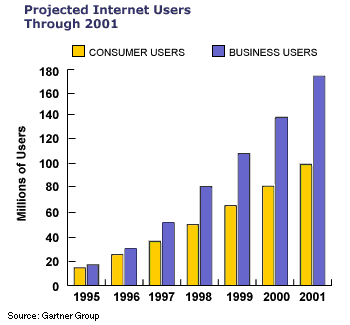
Strategies will vary widely by industry and company, but Gartner Group believes all organizations — large and small, market leaders and followers, the technologically aggressive and the cautious — can use the Web to become more successful and should begin immediately to evaluate the opportunities and risks.
Four Waves of Electronic Commerce
There are two fundamental ways to look at business-to-business EC. One focuses on
transactions and communication, specifically the electronic exchange of information,
goods, services and payments. The other considers how transacting business electronically
affects the development of business relationships.
To understand how computer-based EC has evolved from both perspectives, Gartner Group identifies four distinct waves of electronic commerce (see the chart below).
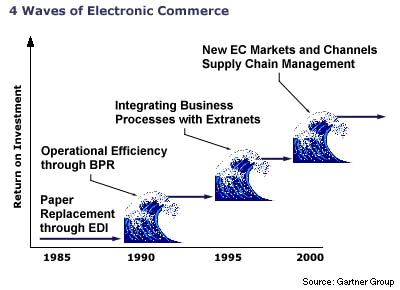
During the first two waves, which gained momentum before the Internet burst forth in the mid-1990s, businesses pursued EC to increase the efficiency of internal processes. Companies aimed to cut the costs of routine business communications by reducing paper flow in such areas as purchasing and procurement. For example, automotive manufacturers exchanged transaction information (e.g., order status and shipping notices) with suppliers and distributors to achieve lower-cost, streamlined just-in-time manufacturing and shipping. Electronic data interchange (EDI) standards for computer-based business-to-business EC expanded business participation in the mid-1980s.
Relationships were an important aspect of early EC since it was mostly conducted on private networks set up by large companies, including General Electric, Ford, General Motors, Wal-Mart and United Parcel Service. The networks gave these companies a trusted electronic gateway to transmit purchase orders, designs, contracts and even funds among their best customers and suppliers who were given private access to these online sites.
Business process re-engineering (BPR) initiated a second wave of EC. BPR involved broad-based reorganizing and streamlining of business activities resulting in increased cross-functional coordination and process improvements in single functional areas such as accounting, distribution and production. By integrating technology more closely with business processes, companies realized greater savings from EDI.
Gartner Group believes the next two waves of EC, which are based on the Internet, will pave the way for many more businesses to leverage EC. It will no longer be a back-office cost-cutting exercise: companies will continue to increase operating efficiencies but will also grow revenues through innovative management of business relationships. In the third wave, which is just beginning, companies are integrating the Internet with BPR. In the next wave, starting sometime toward the end of the millennium — smart businesses will use the Internet to establish new channels for sales, marketing and service. The fourth wave of EC will also enable firms, even require them, to manage continuous supply-chain-wide communication of all types of information.
Both the third and fourth waves of EC are being facilitated by extranets, which are simply a part of an organization’s site on the Internet that is open only to outside parties who are given access to this area. Continuing an EC tradition of closed trade among known partners, a company can use an extranet to selectively share information or execute transactions with its customers and suppliers. Extranets create a unique opportunity not only to take the efficiency benefits of EC to a new level, but also to promote competitive advantage by helping companies to build deeper and one-to-one connections with customers and suppliers.
A Look Back
Before the Internet, large companies like the Big Three automakers or retail giants like
Wal-Mart dominated the development of EC networks. As a result, they also dictated the
kinds of technology used and the costs. The expense to install and maintain networks made
it difficult for smaller or midsize firms — both buyers and sellers — to take
full advantage of EC’s benefits.
 EDI made EC
feasible for more companies but it was still complex and expensive. Value added networks
(VANs) emerged to provide a variety of EC support services to companies (increased network
capacity, software, etc.) However, even though the standards of EDI and the services of
VANs have made it possible for more firms to benefit from EC, the technologies and
processes still require a significant commitment, especially in maintenance and support.
(See Electronic Commerce Before the Internet for details on EDI and VANs.)
EDI made EC
feasible for more companies but it was still complex and expensive. Value added networks
(VANs) emerged to provide a variety of EC support services to companies (increased network
capacity, software, etc.) However, even though the standards of EDI and the services of
VANs have made it possible for more firms to benefit from EC, the technologies and
processes still require a significant commitment, especially in maintenance and support.
(See Electronic Commerce Before the Internet for details on EDI and VANs.)
Enter the Internet
With the recent explosion of the Internet, the EC game is changing. Indeed, the Internet
is about to make business-to-business EC even less expensive and more accessible.
Standards are not an issue on the Web because it is essentially a one-standard-fits-all
network. There are also many more types of software available. It is cheaper to develop
resources and easier to integrate with applications.
Depending on a company’s business objectives, there are essentially three EC paths firms can follow using Internet technologies: the public Web, extranets, or a combination.
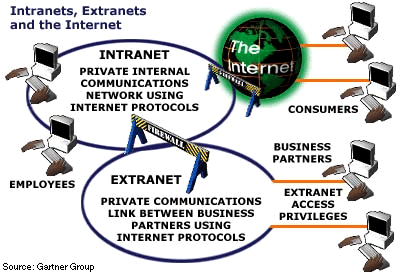
In an electronic marketplace (EM) on the public Internet, enterprises can conduct EC activities anytime with any supplier, distributor or customer. This introduces an openness and variability that contrasts with the controlled trading environments of traditional EC. Advertising, customer support, online ordering and transaction processing are all potential business activities to pursue on the open Web. However, with the exception of advertising, openness introduces complications for each of these activities, including security of systems and information, certification and authentication requirements and information formatting.
Alternatively, firms can choose a more secure extranet path. For some time companies have created internal, closed networks using Internet technology, as a replacement for internal proprietary networks. These are known as Intranets. Extranets take this trend a step further by letting outside companies gain privileged access to a closed corporate network in order to facilitate sales, marketing, research and development and transactions, among many other activities. Extranets allow companies to develop deeper, strategic relationships with business partners — even those they do business with less frequently — without the huge investment that was required to conduct traditional EC.
Extranet-based EC can focus on these and other areas to cut costs but also grow revenues:
- Enterprisewide materials sourcing and procurement
- Customer service and self-service
- Expanded sales and channel management
- Information sharing and document management
- Supply chain management
- Collaborative engineering and concurrent manufacturing
Three companies applying innovative extranet-based strategies include GE Lighting (procurement), Cisco Systems (marketing, sales and customer service) and Fruit-of-the-Loom (supply chain management).
Internet Transforms the VAN
As more organizations recognize the attractions of Internet-based EC, support services are
expanding to help companies establish and grow their business presence on the Web. A new
type of VAN that has adopted Internet standards (known as a value added internetwork
(VAI)) is emerging to offer services and software to facilitate EC over the Internet.
Long-term, VAIs will support the implementation of the ultimate extranet — the
integration of all of an organization’s business processes, supported by back-office
systems, with key business partners.
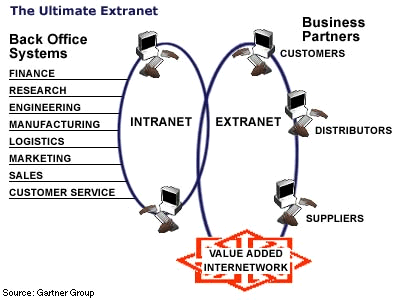
Gartner Group believes that during the first-quarter of 1998, VAIs will overtake traditional VANs in the United States. Emerging VAIs will provide many more services seven days a week, 24 hours a day. These will include network and Internet access, certification services to secure transactions, directories, electronic catalogs, E-mail and bidding and training programs.
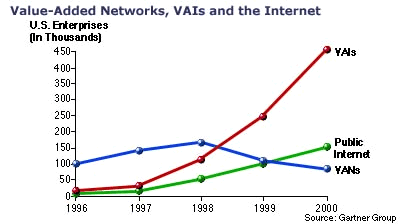
Thus, companies that rely on VANs need to reassess those relationships to determine what types of organizations can provide the best support for EC on the Internet. Besides VAIs, telecommunications companies, Internet service providers, systems integrators and other types of organizations will also offer extranet and other Internet-based EC services.
Challenges Fading
There are a number of corporate management and technology issues that have slowed the
growth of business-to-business Internet commerce. Looking ahead, however, many of the
challenges are rapidly fading.
- Commoditization. As more EC moves to the Internet, companies fear that Web-based tools will allow customers to shop more efficiently for the best price, reducing margins and increasing commoditization of products and services. One of the primary benefits of extranets is that they give control back to the company — control to ensure that the Internet is not compromising the effectiveness of other sales channels or to protect valuable company information from the wandering mouse of a prying competitor.
- Security. Another concern is whether Internet transactions are secure. That, too, is overplayed. Extranets use passwords, firewalls, specialized software and other mechanisms to create an environment that is not as secure as a VAN, but is more secure than the public Internet. In short, an extranet is secure enough to conduct many types of transactions from simple to complex and sensitive. In fact, technologies exist to expand the security of all forms of Web commerce. The challenge is to apply the technology more effectively.
- Critical mass. There will be more than enough customers and suppliers to justify investments in Web commerce. In 1996, Dataquest estimated that $937 million worth of business was transacted electronically, and this does not include the billions of pieces of information that are exchanged daily between organizations, using VANs and EDI. Dataquest predicts that with the introduction of new technology, EDI via the Internet will become more accessible and easier to use for small and medium-size companies, with a potential market of 1.5 million to 2 million businesses. The key industries over the past decade were automotive, industrial goods manufacturing, retail and transportation. These industries will remain EC leaders through 2000, but EC relationships will no longer be totally dominated by a few large companies.
- Efficiency. Improvements in software, hardware and communications technologies are quickly making the Internet efficient enough for more and more business-to-business communications.
- Systems incompatibility. Although technology is available today to create compelling graphical, interactive, multimedia-based interfaces, these are simply fancy front-ends to legacy applications and systems. As yet, Web systems do not take full advantage of the electronic medium since humans are often needed to complete a transaction. Furthermore, back-office business processes that were reconfigured for EDI will need to be revamped again for the Internet. This problem will take longer to overcome, but Gartner Group believes that as organizations shift their technology and business processes to intranets, it will drive the development of extranets since the integration of back-office systems, intranets and extranets is necessary to take full advantage of Web commerce opportunities. However, most early extranets will be tactical extensions of departmental and function-specific intranets. Over the next five years, few companies, other than market leaders, will build enterprise-scale virtual trading environments using extranets because of the technical and management difficulties involved in integrating all of an organization’s business processes and back-office systems with those of its business partners.
- Management gaps. Most companies treat Web commerce as a project rather than as a strategic business initiative. Projects tend to be narrowly defined and, therefore, have little effect on corporatewide business performance. Until companies start addressing the Web as a new channel, and appoint people with clear revenue targets to manage it, enduring commercial success on the Internet will be elusive.
Weighing Options
Extranets are by no means the only or right option for companies. But as long as
businesses continue to worry about their exposure on public Web sites, extranets will have
a strong appeal. Further, clear business benefits of extranets are easy to quantify. For
one, they provide an excellent rallying point for top management to encourage
participation in the Internet craze, while doing it in a prudent way that protects market
share and improves business process efficiency. An extranet lowers the cost to share
information and integrate applications with multiple trading partners. It also holds the
promise of enhancing competitive advantage by deepening relationships with key customers.
Gartner Group expects extranets will play a key role in the technology-enabled
relationship management (TERM) processes used to collect and analyze data to establish
closer relationships with customers.
With so many clear-cut benefits, the extranet EC market is ready to take off. By the end of 1999, Gartner Group forecasts that more than 40 percent of large companies will be using these networks. By 2001, extranets will also be the platform for more than 40 percent of business-to-business EC communications.
Like any strategy involving the Internet, there are many issues to consider. The following action items should be at the top of the list for any company considering an extranet:
- Have clear business goals. The wrong and common approach is to focus on technology first. The right approach is to identify the specific business goals. Is the firm trying to open up a new sales channel or make an existing one more efficient? Once that decision is made, the next step is to think about the resources needed to achieve the goal. It may or may not be an extranet.
- Conduct detailed planning. Develop a tactical and strategic plan for how to best
use extranets to facilitate business partner access to internal systems. Evaluate key
business partners’ willingness and ability to participate in the extranet given the
objectives set out in the business plan. Perform a cost-benefit analysis to determine the
degree to which an extranet will enhance or detract from existing business processes.
Evaluate products and services to identify gaps in information technology resources. Set
appropriate corporate and business unit expectations and time-lines.
- Determine extranet type. Gartner Group has identified three types of extranets: egocentric, polycentric and community. Companies can use these classifications in their assessment of strategic needs. (See Three Types of Extranets.)
- Create a secure environment. The simplest way to do this cost-effectively is to use passwords. But exotic technologies, like smart cards and palm print readers, work even better to restrict access to unauthorized people and companies. An expensive security solution could impact the acceptance of the extranet as it increases implementation costs.
- Identify competitive or operational gains. Make sure through cost/benefit analysis that an extranet brings your company real gains in reduced costs, efficiencies and revenue growth.
- Seek acceptance from trading partners. Extranets place some technology and installation requirements on customers and suppliers, though they are not as great as those for EC through VANs. To gain the greatest returns from extranets, companies need to ensure that their partners understand and appreciate the potential for sharing information via an extranet.
Getting In Position
As companies design Internet strategies they should consider their strength in the
marketplace and approach the Internet accordingly. Over the next 24 months, market
leaders, middle market and small companies should establish extranet plans to suit their
business requirements.
Market leaders can use their market clout to get business partners and eventually competitors to join an egocentric extranet. It is assumed that these companies already have a Web presence. Thus, market leaders should cement their dominance, cut costs, and simplify processes. Through the first-quarter 1998, these companies should develop business plans for using extranets to accomplish the following goals with business partners:
- Publishing
- Information sharing
- Distribution channel expansion
Middle market firms should develop solid back-end applications and integrate their processes with both their customers and suppliers. These mid-size firms will not have the influence to dictate business standards and processes for a large group of trading partners, but they will not be forced into a larger competitor’s extranet either. Through first-quarter 1998, these companies should make sure that they have a strategy for their Web site. Through third-quarter 1998, these companies should have a strategy for the following activities:
- Publishing
- Information sharing
Small firms should expand their presence in as many extranets or electronic marketplaces as possible. Although this will prohibit smaller firms from developing strong, integrated applications to cut costs and lock in customers, it could increase their visibility and opportunities to gain revenue. Smaller firms should not feel pressure to implement Web sites until the third quarter of 1998. From third-quarter 1998 to third-quarter 1999, smaller companies should create a strategy for the following activities:
- Publishing
- Information sharing
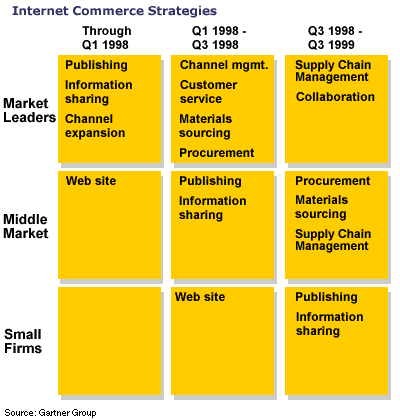
Business First
Gartner Group expects most organizations will spend two to four years getting the right
processes fully functional for Internet-based EC. The most important factors to achieve
success on the Web do not depend on the technologies used, but on the ability of an
enterprise to effectively manage its business with the help of technology.
One challenge will be to keep pace with business process changes that occur while implementation proceeds. Success will come from the enterprise’s ability to integrate Internet business strategies into overall corporate goals, understanding that the technologies are only tools to build a presence in electronic marketplaces, and that the tools will not fulfill their potential without a solid business vision and plan.
Entire contents © 1997 by Gartner Group, Inc. All rights reserved. Reproduction of this publication in any form without prior written permission is forbidden. The information contained herein has been obtained from sources believed to be reliable. Gartner Group disclaims all warranties as to the accuracy, completeness or adequacy of such information. Gartner Group shall have no liability for errors, omissions or inadequacies in the information contained herein or for interpretations thereof. The reader assumes sole responsibility for the selection of these materials to achieve its intended results. The opinions expressed herein are subject to change without notice.